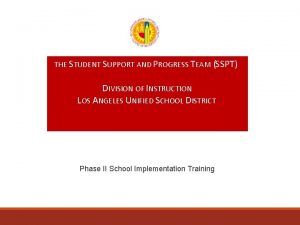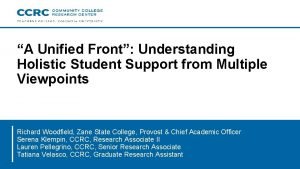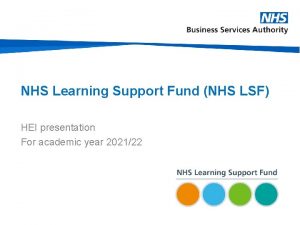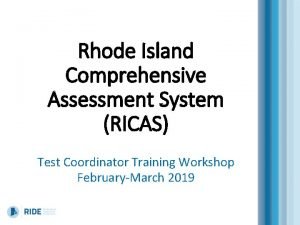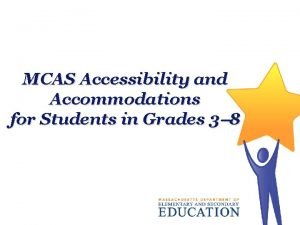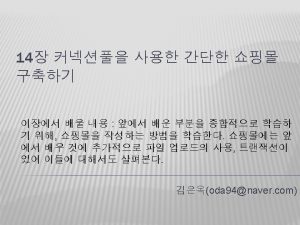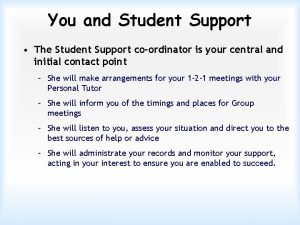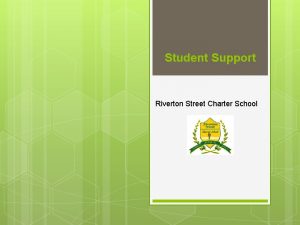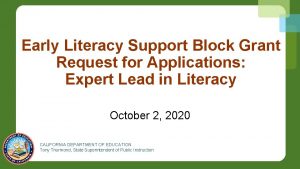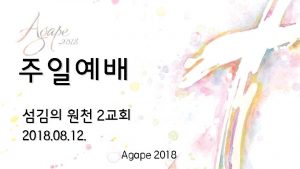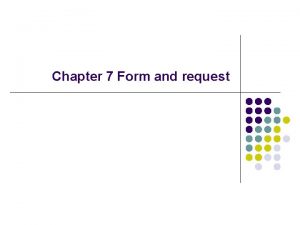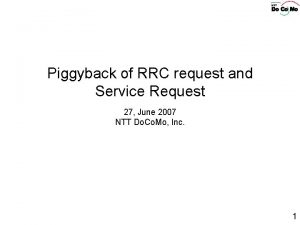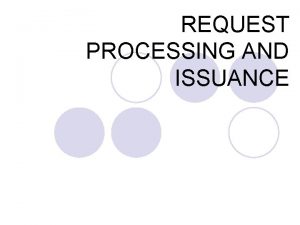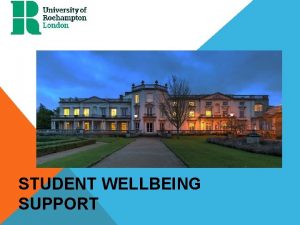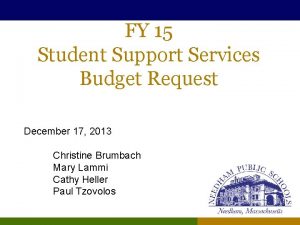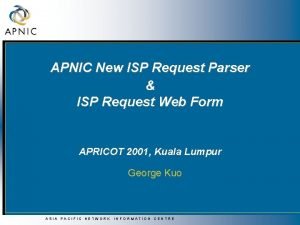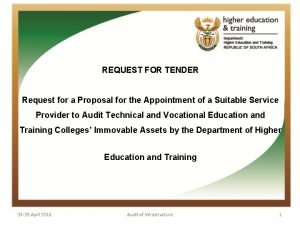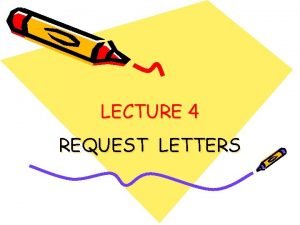2018 19 Request for Applications Student Support and








































- Slides: 40

2018– 19 Request for Applications Student Support and Academic Enrichment Grant Program Technical Assistance Webinar Presented by the Educator Excellence and Equity Division on August 28, 2018 CALIFORNIA DEPARTMENT OF EDUCATION Tom Torlakson, State Superintendent of Public Instruction

Housekeeping • Webinar participants have been placed on mute • Question/Answer session toward the end of the webinar • Power. Point with the notes are available on the CDE SSAE web page at https: //www. cde. ca. gov/pd/ps/ssaecgp 2018. asp

2018– 19 Student Support and Academic Enrichment Grant Program • The Student Support and Academic Enrichment (SSAE) Program is authorized under Title IV, Part A of the Elementary and Secondary Education Act, as amended by the Every Student Succeeds Act (ESSA) of 2015 (Federal Catalog Number 84. 424 A). Deadline for Notice of Intent to Submit an Application: Wednesday, September 12, 2018 Deadline for Applications: Wednesday, October 17, 2018

Program Authorization • This Request for Application is for the SSAE Competitive Grant Program. • ESSA established Title IV, Part A as a formula grant. • The Federal Consolidated Appropriations Act of 2017 provided states with the option to award 2017– 18 SSAE funds as a competitive grant. • Formula SSAE grants are coming soon.

SSAE Grant Purpose The purpose of the SSAE grant is to encourage and support eligible local educational agencies (LEAs), including direct-funded charter schools, to increase capacity to: A. Provide all students with access to well-rounded educational opportunities; B. Support safe and healthy students; and C. Support the effective use of technology.

SSAE Grant Categories LEAs or a consortium of LEAs may submit up to three applications, one for each category: • Category A: Access to, and opportunities for, a well-rounded education for all students; • Category B: School conditions for student learning in order to create a healthy and safe school environment; or • Category C: Access to personalized learning experiences supported by technology and professional development for the effective use of data and technology.

SSAE Priority Points 1. Enhance visual and performing arts education (4 points), and/or 2. Utilize these funds as part of a comprehensive strategy to expand access to physical and mental health care, including dental and vision care, in schools by supporting the planning, establishing, updating, or the expanding of school health centers, including, but not limited to, mobile school health centers, as defined in Section 124174 of the Health and Safety Code, except that no funds shall be used for the purpose of construction, renovation, or repair of any school facility (4 points). 3. LEAs that have been identified for differentiated assistance under the statewide system of support (1 point).

SSAE Grant Duration • The grant period is January 1, 2019, through September 30, 2019*. *The CDE is requesting a Tydings Amendment Waiver from the U. S. Department of Education (ED). If the waiver is accepted by the ED, grantees will be provided the opportunity to submit a request to the CDE for an extension beyond September 30, 2019, and carryover any unspent funds.

SSAE Eligibility • Must be an LEA, or a consortium of LEAs, that received a grant under Title I, Part A of ESEA in the 2017– 18 fiscal year • The list of eligible LEAs is available on the Title I, Part A Funding Results web page at https: //www. cde. ca. gov/fg/aa/ca/title 1 pa 17 result. asp.

SSAE Eligibility cont. • Lead consortia members may be districts or direct-funded charter schools and consortia members may include districts and/or direct-funded charter schools. • Eligible districts or charter schools may apply individually or as part of a consortium, but not both. • The consortium lead must be an active participant in the consortium and cannot act solely as a flow-through for grant funds. • Consortia members must be located in the same CCSESA region.

SSAE Funding The CCSESA Region Map is available on the CCSESA web page at http: //ccsesa. org/members/region-map/. • $4 million in grants, based upon merit, to each of the eleven California County Superintendents Educational Service Association (CCSESA) service regions to provide statewide geographical diversity. • Applications submitted by an LEA, or a consortium of LEAs, shall be for $500, 000 or more.

Allowable SSAE Grant Activities

Allowable SSAE Grant Activities: Category Focus • LEAs may incorporate aspects of the other grant categories into an application for one grant category. However, the LEA will be required to allocate at least 20 percent of its proposed budget for allowable activities listed in the grant category for which it is applying. • Activities supporting Category A (well-rounded educational opportunities) and Category B (safe and healthy students) may be conducted in partnership.

Well-Rounded Educational Opportunities Programs and activities that support a well-rounded education may* include: • College and career guidance and counseling programs • Music and the arts • Science, technology, engineering, and mathematics, including computer science (STEM) • Accelerated learning programs • Foreign language instruction • Environmental education • Volunteerism and community involvement • Programs and activities that integrate multiple disciplines • Other programs that support wellrounded education experiences *Note: This list provides examples of allowable activities and is not an exhaustive list. Please consult the statute for more information. The text of ESEA sections 4107, 4108, and 4109 is available in Appendix B of the Request for Application.

Safe and Healthy Students Programs and activities that support safe and healthy schools may* include: • Preventing bullying and harassment • School readiness and academic success • Relationship building skills • Child sexual abuse awareness and prevention • School dropout prevention • Re-entry programs and transition services for justiceinvolved youth • Reducing use of exclusionary discipline practices & promoting supportive school discipline • Suicide prevention *Note: This list provides examples of allowable activities and is not an exhaustive list. Please consult the statute for more information. The text of ESEA sections 4107, 4108, and 4109 is available in Appendix B of the Request for Application.

Effective Use of Technology Programs and activities that support effective use of technology may* include: • Supporting high-quality • Providing students in rural, professional development for remote, and underserved areas educators, school leaders, and with the resources to benefit administrators to personalize from high-quality digital learning and improve academic opportunities achievement • Delivering specialized or • Building technological capacity rigorous academic courses and infrastructure curricula using technology, • Carrying out innovative blended including digital learning technologies and assistive learning projects technology *Note: This list provides examples of allowable activities and is not an exhaustive list. Please consult the statute for more information. The text of ESEA sections 4107, 4108, and 4109 is available in Appendix B of the Request for Application.

Requirements of the SSAE Grant Application

Submission Requirements • Applicants must respond to all sections of the RFA. • Structure the application to follow the guidelines provided in the application format and table of contents sections of the RFA. • A rubric (Appendix C) has been provided to describe response expectations for each section of the application and other program requirements. • Applicants responding to this RFA must submit a complete application packet, including a complete response to all items described in this RFA, required forms, and all required original signatures as noted on each application form.

Intent to Submit an Application The Form A: Intent to Submit an Application for the Title IV, Part A 2018 Student Support and Academic Enrichment Grant Program must be received by the CDE via email or fax by 5 p. m. on Wednesday, September 12, 2018. https: //www. cde. ca. gov/fg/fo/r 12/ssaecgp 18 rfa. asp

Comprehensive Needs Assessment Proposals must reflect the unique aspects of the regional and local context the application represents. Subgrant recipients must conduct a comprehensive needs assessment in order to examine needs for improvement of: • Access to, and opportunities for, a well-rounded education for all students: • School conditions for student learning in order to create a healthy and safe school environment; and/or • Access to personalized learning experiences supported by technology and professional development for the effective use of data and technology.

Consultation with Stakeholders ESEA Section 4106(c)(1) requires LEAs to develop their applications through consultation with the following stakeholders: • • Parents Teachers Principals Other school leaders Specialized instructional support personnel Students Community-based organizations

Consultation with Stakeholders cont. • Indian tribes or tribal organizations that may be located in the region served by the LEA (where applicable) • Local government representatives (which may include a local law enforcement agency, local juvenile court, local child welfare agency, or local public housing agency) • Charter school teachers, principals, and other school leaders, if supported by the LEA or consortium of LEAs • Others with relevant and demonstrated expertise in programs and activities designed to meet the purposes of this program

Equitable Services • ESEA Section 8501(a)(4) requires that expenditures for services to private school students, teachers, and other educational personnel be equal to the expenditures for the public school program, taking into account the number and educational needs of the children to be served. • Engage in a process of timely and meaningful consultation with private school officials during the development of its application and throughout the grant period.

Supplement, Not Supplant Requirement • In considering how to use SSAE programs funds, LEAs should be mindful that SSAE program funds may be used only to supplement, and not supplant, non-federal funds that would otherwise be available for activities under the SSAE program. • This means, in general, that LEAs may not use SSAE program funds for the cost of activities if the cost of those activities would have otherwise been paid with state or local funds in the absence of SSAE program funds.

Completing the Project Narrative • Must address the seven proposal sections. • Must not exceed 20 double-spaced pages, using 12 -point Times New Roman or Arial font with one-inch margins. • Must be conceptually clear, technically feasible, and sustainable after the grant period.

Parts 1 and 2 of the Project Narrative • Part 1 The Context Proposals must document the local and regional needs specific to the category of improvement and, if applicable, priority area, within the targeted LEAs served by this proposal. • Part 2: Strategies and Interventions Proposals must describe how the project activities address the chosen category (A, B, or C) and, if applicable, integrate the priority area(s) (1 and/or 2). This section must show the project activities will address the specific needs identified in Part 1 and will advance the project toward meeting its goals and measurable objectives.

Parts 3 -5 of the Project Narrative • Part 3: Project Leadership Proposals must describe the role and contribution of each collaborative partner to the operational success of the project and the achievement of its goals. • Part 4: Project Staff Applicants must demonstrate their ability to implement and maintain a successful SSAE program. • Part 5: Project Participants Proposals must describe how the project will ensure enthusiastic, engaged, and sustained participation by all participants in every phase.

Parts 6 and 7 of the Project Narrative • Part 6: Evaluation Plan Proposals must demonstrate that the project’s proposed evaluation plan is conceptually clear, integrated with the project goals and objectives, and technically feasible. • Part 7: Budget and Cost Effectiveness The applicant must provide a thorough and detailed justification for each identified cost associated with implementing the proposed initiatives and goals, including why the costs are reasonable and necessary to support the proposal’s initiatives and goals. A ninemonth projected budget is required for the application. The ninemonth budget will be reviewed and scored.

Review Process • Only fully completed applications will be considered eligible for consideration and advanced to the Reader Conference. • A panel of readers selected for their expertise will read, review, and score each eligible application using a scoring rubric (see Appendix C of the SSAE RFA). • Readers will be instructed to read each proposal in its entirety to get an overall impression of the project and whether it makes sense overall. • Points will be awarded based on completeness and responsiveness of the application to each of the required application components.

Review Process cont. Grants may not necessarily be made to applications that have the highest scores. When selecting projects to award, the Panel Chairs will consider statutory requirements that: • Prioritize the distribution of funds to schools served by the applicant that have the highest percentages or numbers of children counted under ESSA section 1124(c); • Ensure there is geographic diversity among subgrant recipients representing rural, suburban, and urban areas within the state; and • Require that, of the total $44, 080, 000 awarded, at least 20 percent of funds support activities under ESEA Section 4107, at least 20 percent of funds support activities under ESEA Section 4108, and some portion of funds support activities under ESEA Section 4109.

Application Maximum Point Values Section Description Point Value Part 1 The Context 4 points Part 2 Strategies and Interventions 4 points Part 3 Project Leadership 4 points Part 4 Project Staff 4 points Part 5 Project Participants 4 points Part 6 Evaluation Plan 4 points Part 7 Budget and Cost Effectiveness 4 points Priority Points Extra points for Priority Area 1 4 points Priority Points Extra points for Priority Area 2 4 points Priority Point 1 point At least one district identified for differentiated assistance

SSAE Grant Checklist • Page two of the SSAE Application contains a checklist to ensure that all required components have been completed.

SSAE Grant Application Timeline Activity Important Dates Intent to Submit an Application September 12, 2018 (5 p. m. PST) Applications Due October 17, 2018 (5 p. m. PST) Readers Conference November 8 and 9, 2018 Posting of Intent to Award Deadline for receipt of any appeal November 13, 2018 Project Start Date January 1, 2019 November 20, 2018 Signed Grant Award Notification January 30, 2019 Due

Submission of Application Send: - One original application - Five copies - Flash drive with soft copy of application (saved in Microsoft Word) Must be received by the CDE Educator Excellence and Equity Division by 5 p. m. on Wednesday, October 17, 2018.

Submission of Application cont. Mail or deliver applications to: Educator Excellence and Equity Division California Department of Education 1430 N Street, Suite 4309 Sacramento, CA 95814 Attention: Julia Agostinelli

Additional Resources (1) Applicants should be familiar with the following resources that contain further information regarding requirements and guidance for the program: • U. S. Department of Education (ED) Title IV, Part A, Student Support and Academic Enrichment Grants Guidance available at http: //www 2. ed. gov/policy/elsec/leg/essassaegrantguid 10212 016. pdf (Note: This document does not address the provisions of the Consolidated Appropriations Act of 2017 linked to below. Both documents should be considered in tandem. )

Additional Resources (2) • ED Fiscal Changes and Equitable Services Requirements Guidance available at http: //www 2. ed. gov/policy/elsec/leg/essaguidance 160477. pdf • National Center on Safe Supportive Learning Environments Title IV, Part A web page available at https: //safesupportivelearning. ed. gov/ESSA-Title. IVPart. A-SSAE (Note: Please refer to resources regarding FY 2017 Title IV, Part A Funds. ) • Provisions in the Consolidated Appropriations Act of 2017 available at https: //safesupportivelearning. ed. gov/sites/default/files/Provisions. C onsolidated. Appropriations. Act 2017_Title%20 IVASSAE. pdf

Additional Resources (3) • Webinar Slides: Changes to the Title IV, Part A, SSAE Grants Resulting from the FY 2017 Department of Education Appropriations Act available at https: //safesupportivelearning. ed. gov/sites/default/files/TIVPA%20 SSAE%20 Webinar%204%20 Slides%20 v 7%205. 24. 2017. pdf • Subgranting FY 2017 Title IV-A Funds to LEAs: Questions and Answers available at https: //safesupportivelearning. ed. gov/sites/default/files/Subgranting _FY_2017_Title_IV_A_LEAs_QA. pdf

Questions?

Educator Excellence and Equity Communications For additional information, contact: Marcia Trott, Julia Agostinelli, or Joy Kessel Education Programs Consultants Educator Excellence and Equity Division Telephone: 916 -322 -9503 Fax: 916 -319 -0136 Email: EEED@cde. ca. gov
 B a f c j e
B a f c j e Major and minor details examples
Major and minor details examples Lausd sspt forms
Lausd sspt forms Holistic student support
Holistic student support Nhs learning support fund regional incentive
Nhs learning support fund regional incentive Ricas.pearsonaccessnext.com
Ricas.pearsonaccessnext.com Mcas accessibility and accommodations
Mcas accessibility and accommodations Kontinuitetshantering
Kontinuitetshantering Typiska drag för en novell
Typiska drag för en novell Tack för att ni lyssnade bild
Tack för att ni lyssnade bild Ekologiskt fotavtryck
Ekologiskt fotavtryck Varför kallas perioden 1918-1939 för mellankrigstiden?
Varför kallas perioden 1918-1939 för mellankrigstiden? En lathund för arbete med kontinuitetshantering
En lathund för arbete med kontinuitetshantering Personalliggare bygg undantag
Personalliggare bygg undantag Tidböcker
Tidböcker Anatomi organ reproduksi
Anatomi organ reproduksi Förklara densitet för barn
Förklara densitet för barn Datorkunskap för nybörjare
Datorkunskap för nybörjare Boverket ka
Boverket ka Hur skriver man en debattartikel
Hur skriver man en debattartikel Delegerande ledarskap
Delegerande ledarskap Nyckelkompetenser för livslångt lärande
Nyckelkompetenser för livslångt lärande Påbyggnader för flakfordon
Påbyggnader för flakfordon Arkimedes princip formel
Arkimedes princip formel Publik sektor
Publik sektor Jag har nigit för nymånens skära
Jag har nigit för nymånens skära Presentera för publik crossboss
Presentera för publik crossboss Teckenspråk minoritetsspråk argument
Teckenspråk minoritetsspråk argument Plats för toran ark
Plats för toran ark Klassificeringsstruktur för kommunala verksamheter
Klassificeringsstruktur för kommunala verksamheter Luftstrupen för medicinare
Luftstrupen för medicinare Claes martinsson
Claes martinsson Centrum för kunskap och säkerhet
Centrum för kunskap och säkerhet Byggprocessen steg för steg
Byggprocessen steg för steg Mat för unga idrottare
Mat för unga idrottare Verktyg för automatisering av utbetalningar
Verktyg för automatisering av utbetalningar Rutin för avvikelsehantering
Rutin för avvikelsehantering Smärtskolan kunskap för livet
Smärtskolan kunskap för livet Ministerstyre för och nackdelar
Ministerstyre för och nackdelar Tack för att ni har lyssnat
Tack för att ni har lyssnat Referat mall
Referat mall


